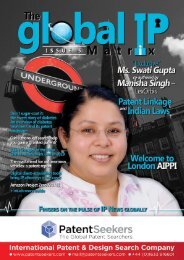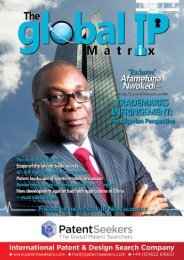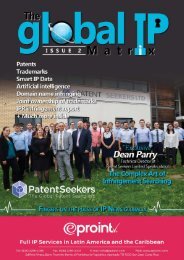Global IP Matrix - Issue 8
Dear Readers We are delighted to present you with issue 8 of The Global IP Matrix magazine! Once again, we have fantastic content delivered to you by industry professionals who are experts in their field. This issue explores IP & Innovation in Africa, anti-counterfeiting measures in the Caribbean, IPR Infringement in China, plus many more engaging articles around the IP ecosystem. It's been a challenging few months; however, we are grateful that our clients and contributors share our vision. Together, we are heading for better times. We cannot thank our authors enough for their time and efforts to keep you, our audience up to date with news and stories from their own perspective and expertise. Look out for our next edition, in January 2021 and until then, stay safe, healthy & happy. Elvin Hassan – Editor
Dear Readers
We are delighted to present you with issue 8 of The Global IP Matrix magazine!
Once again, we have fantastic content delivered to you by industry professionals who are experts in their field.
This issue explores IP & Innovation in Africa, anti-counterfeiting measures in the Caribbean, IPR Infringement in China, plus many more engaging articles around the IP ecosystem.
It's been a challenging few months; however, we are grateful that our clients and contributors share our vision. Together, we are heading for better times.
We cannot thank our authors enough for their time and efforts to keep you, our audience up to date with news and stories from their own perspective and expertise.
Look out for our next edition, in January 2021 and until then, stay safe, healthy & happy.
Elvin Hassan – Editor
Create successful ePaper yourself
Turn your PDF publications into a flip-book with our unique Google optimized e-Paper software.
Classification analysis
Figure 2 shows the number of publications placed in the top 20 International Patent Classifications over time. This provides a unique
insight into the fight against the opioid crisis, with classifications showcasing both drugs/medication for treating opioid addiction as well
as for combating the side-effects of an opioid overdose. The patent classifications showing the heaviest volume of activity are A61P25/36
(Drugs for opioid abuse) and A61P25/00 (Drugs for disorders of the nervous system), which comes as no surprise**. Other classifications
exhibiting relatively higher activity include A61P25/18 (Antipsychotics), A61P25/22 (Anxiolytics), A61P25/24 (Antidepressants),
A61P25/28 (treating neurodegenerative disorders of the central nervous system), and A61P25/32 (alcohol abuse), which all fall under the
parent classification of A61P25, noted as the second most active classification. The increased activity in these classifications could indicate
a desire to treat other conditions often associated with opioid addiction and abuse in an effort to increase the success of opioid addiction/
abuse treatments. For the most part, activity appears to have occurred in each classification in most years, with the exceptions of A61K31/44
(Medical preparations with non-condensed pyridines), A61P25/06 (Antimigraine), A61P25/20 (Hypnotics; Sedatives), and A61P9/10 (for
treating ischaemic or atherosclerotic diseases) which all appear to either have large gaps between activity or have not seen any activity at all
for a number of years.
Figure 3. Opioid addiction/abuse-related patent family map
Figure 2: The number of publications placed in the top 20 IPCs (International Patent Classifications) over time.
** The patent classification A61P25/36 was used in the creation of the initial dataset; as such, it is expected to be the
patent classification present with the highest level of activity. However, when removed from the dataset, it still retains
this position.
Technology Landscape Analysis
Figure 3 illustrates a set of documents clustered according to their semantic proximity, where a point corresponds to a patent family. The
map provides a visualisation of the technology clusters prevalent within the opioid abuse treatment portfolio and reveals a diverse set of
interests. A range of different treatment approaches are covered, from antagonising molecules to tamper resistant dosage forms. Morphine
addiction (dark grey dots) appears to show the greatest concentration of patents. However, the difference appears to be largely negligible,
with all concentrations appearing to be of almost equal size. Most clusters appear to relate to opioids in general; however, morphine
seems to be the most common of opioids that appears within the clusters (light blue dots & dark grey dots). Some clusters may indicate
the prevalence of health efforts centred around combination treatments, where other conditions are treated simultaneously with opioid
addiction in an effort to increase their effectiveness (purple dots, dark pink dots). Interestingly there appears to be some innovation
surrounding the continued exploitation of the rewarding properties of opioids. Furthermore, reducing their side effects (light pink dots)
potentially show a desire for the continued use of opioids and their powerful painkilling properties and an understanding of their equally
powerful addictive properties and a desperate need to address these if these drugs are to continue being prescribed.
Conclusion
In analysing the patent landscape
surrounding the fight against the opioid
crisis, it has revealed that the most
significant innovation levels in the
industry took place over a decade ago,
uncoincidentally peaking in the same year
that the WHO added buprenorphine as
complementary medicine to the Model
List of Essential Medicines. Since then,
however, patent filings have significantly
decreased. It will undoubtedly be a slow
and challenging process to reverse this
crisis, and although numerous countries
are now trying to combat the growing
incidents of opioid addiction/abuse, there
seems to be little in the way of innovation.
Perhaps this means that the current
technology and medicaments are deemed
enough, that patents were not the solution
to the problem, or maybe new approaches
that place emphasis on addiction/abuse
prevention and mental health initiatives
could be more effective approaches. Only
time will tell if the world is doing enough to
stem the tide, and the next few years will be
paramount in determining whether greater
innovation in this area is needed.
Be sure to take a look at next quarters’ issue
to see Part 2, where we take a look at global
distribution, the major players in the field,
and the controversy that surrounds them!
20 www.gipmatrix.com www.gipmatrix.com
21












